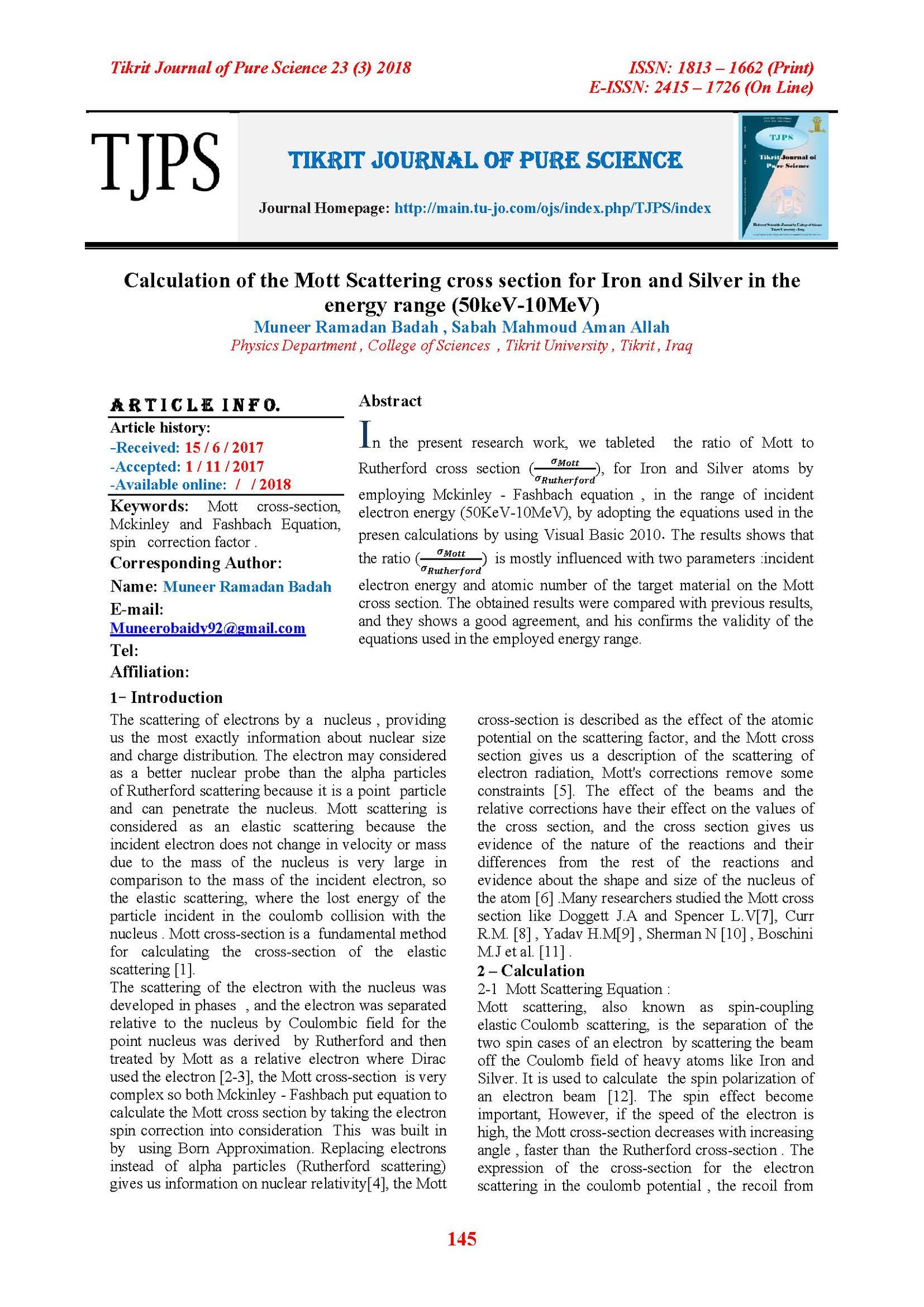Calculation of the Mott Scattering cross section for Iron and Silver in the energy range (50keV-10MeV)
Main Article Content
Abstract
In the present research work, we tableted the ratio of Mott to Rutherford cross section ( ), for Iron and Silver atoms by employing Mckinley - Fashbach equation , in the range of incident electron energy (50KeV-10MeV), by adopting the equations used in the presen calculations by using Visual Basic 2010. The results shows that the ratio ( is mostly influenced with two parameters :incident electron energy and atomic number of the target material on the Mott cross section. The obtained results were compared with previous results, and they shows a good agreement, and his confirms the validity of the equations used in the employed energy range.
Article Details

This work is licensed under a Creative Commons Attribution 4.0 International License.
Tikrit Journal of Pure Science is licensed under the Creative Commons Attribution 4.0 International License, which allows users to copy, create extracts, abstracts, and new works from the article, alter and revise the article, and make commercial use of the article (including reuse and/or resale of the article by commercial entities), provided the user gives appropriate credit (with a link to the formal publication through the relevant DOI), provides a link to the license, indicates if changes were made, and the licensor is not represented as endorsing the use made of the work. The authors hold the copyright for their published work on the Tikrit J. Pure Sci. website, while Tikrit J. Pure Sci. is responsible for appreciate citation of their work, which is released under CC-BY-4.0, enabling the unrestricted use, distribution, and reproduction of an article in any medium, provided that the original work is properly cited.
References
[1] Mott, Nevill Francis, and Harrie Stewart Wilson Massey." The theory of atomic collisions". Vol. 35. Oxford: Clarendon Press, (1965).
[2] Oen, O. S. "Cross sections for atomic displacements in solids by fast electrons". No. ORNL--4897. Oak Ridge National Lab., Tenn.(USA), (1973).
[3] Thomson, Mark." Modern particle physics". Cambridge University Press,( 2013).
[4] Czyżewski, Zbigniew, et al. "Calculations of Mott scattering cross section." Journal of Applied Physics 68.7 , (1990). [5] Nagashima, Yorikiyo. "Elementary Particle Physics: Foundations of the Standard Model". Vol. 2. John Wiley & Sons, (2013).
[6] Sigmund, Peter. "Particle Penetration and Radiation Effects" Vol.2. 179 Springer Series in Solid State Sciences. Springer Heidelberg,( 2014).
[7] Doggett, Ja A., and L. V. Spencer. "Elastic scattering of electrons and positrons by point nuclei." Physical Review 103.6 ,(1956).
[8] Curr, R. M. "The Coulomb scattering of high-energy electrons and positrons by nuclei." Proceedings of the Physical Society. Section A 68.3 , (1955).
[9] Yadav, H. N. "The nuclear scattering of electrons by uranium." Proceedings of the Physical Society. Section A 68.4 ,(1955).
[10] Sherman, Noah. "Coulomb scattering of relativistic electrons by point nuclei." Physical Review 103.6, (1956).
[11] Boschini, M. J., et al. "An expression for the Mott cross section of electrons and positrons on nuclei with Z up to 118" Radiation Physics and Chemistry 90, (2013).
[12] McParland, B. J." Medical radiation dosimetry" . ch.1 pp.22-23, Springer (2014).
[13] Podgoršak, Ervin B. "Radiation physics for medical physicists. Berlin". Ch.2 pp.113-114, Springer , (2006).
[14] Ianniello, Annarita, and Luigi Mansi. "Brian J. McParland: Nuclear medicine radiation dosimetry. Advanced theoretical principles." European Journal of Nuclear Medicine and Molecular Imaging 38.7, (2011) .
[15] Crawford, James H., and Lawrence M. Slifkin." Point Defects in Solids: General and ionic crystals". Springer Science & Business Media, (2013).
[16] Idoeta, R., and F. Legarda. "Review and calculation of Mott scattering cross section by unscreened point nuclei." Nuclear Instruments and Methods in Physics Research Section B: Beam Interactions with Materials and Atoms71.2 (1992).
